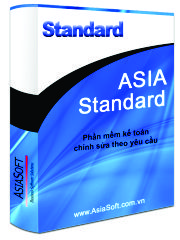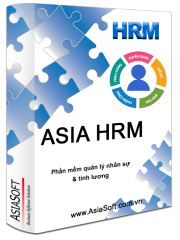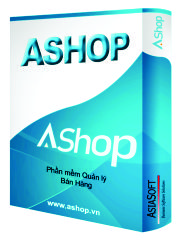Overview
GOALS & OBJECTS
- These solutions are made to manage the fields of investment – construction & real estate by AsiaSoft so as to meet the following objectives:
- Closely managing the workflow of the departments
- Keeping records of all information related to the activities of the departments for accurate information lookup.
- Controlling the progress of work in each department. Having adequate database for statistical analysis and reports for daily, weekly, monthly, quarterly and yearly reports.
- Connecting and making sure of data consistency across the company, inheriting information and data from relevant departments, minimizing data entry and minimizing errors.
- Target clients who refer and use these solutions are companies doing business in the fields of investment – construction, real estate business or broker.
OPERATIONAL MODULES
The solution system includes several modules, which can operate independently or can be connected together to automatically share information with others to create a centralized and unified management system.
- System management
- Specific features
- Project Management (investors)
- Professional management of construction/installation contractors
- Business management of real estate
- Other modules
- Finance – Accounting management
- Cash & banking
- Goods/services purchasing and payables
- Services selling and receivables
- Tour cost & price management
- Inventories
- Fixed assets, instruments and tools
- Summary & financial statements, tax reports
- Human resources management and payroll calculation
- Finance – Accounting management
Feature
MODEL OF INSTALLATION, ORGANIZATION, DATA MANAGEMENT AND STORAGE
SYSTEM SETTING MODEL
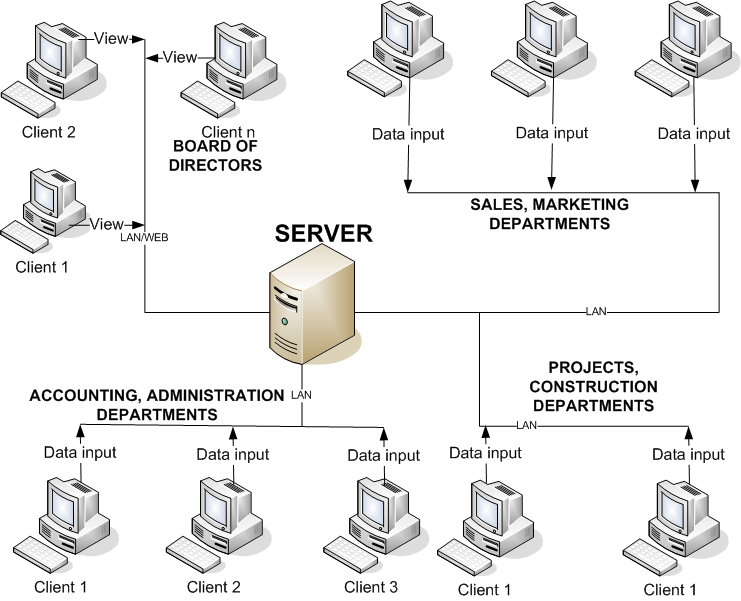
SOLUTIONS FOR DATA CONNECTION AMONG THE DEPARTMENTS, MANAGEMENT OBJECTS
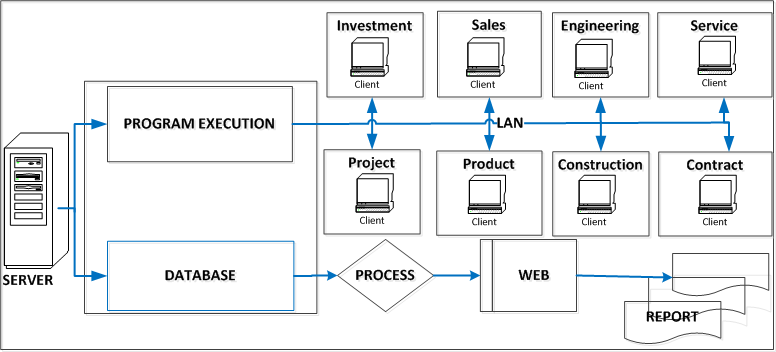
DATA STORAGE AND TRANSMISSION MODEL
System data organizational model:
- Database of all companies (units) are held on a centralized management SERVER – DATACENTER.
- Depending on the needs and nature of work of each unit (company), AsiaSoft will install the system functions accordingly (Receipts – payments, billing – sales, etc.) directly at the office of each unit in order to meet the demand of use upon problems on the host system and transmission center in the model below:
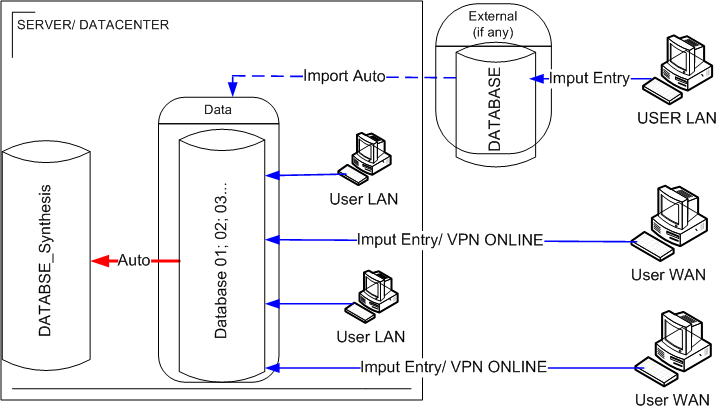
Data transmission mechanism of the whole system
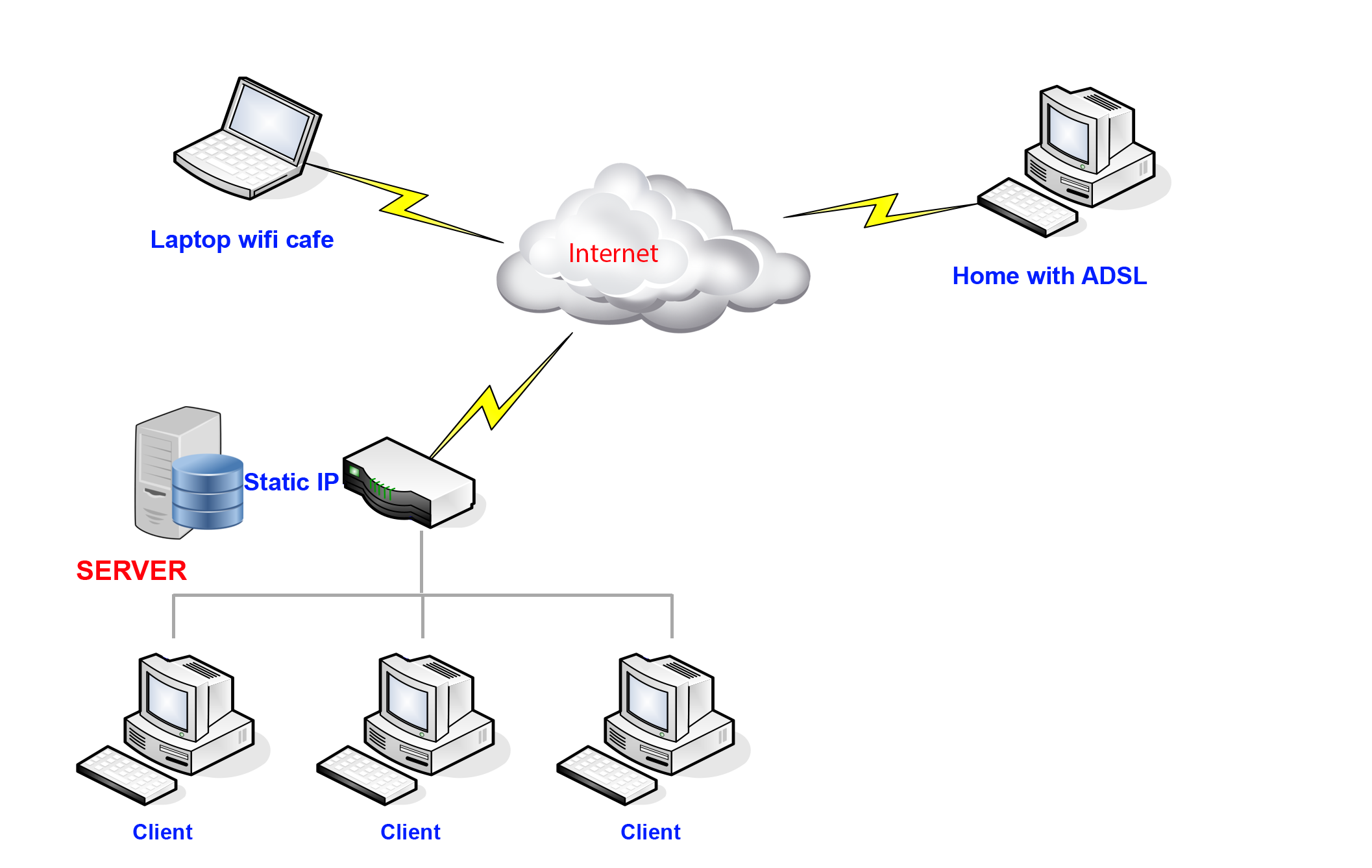
OVERVIEW OF THE FUNCTIONS AND UTILITIES OF THE SOLUTIONS:
PROJECT MANAGEMENT (INVESTORS);
Declaration of the project portfolio and the list of information related to the project:
- Investment project portfolio:
- Project overview: Project Code, Project Name, Project Location
- Basic project information: Investor, Address/Phone number, Representative/Position, Area, Total investment/equity, and the estimated completion time.
- Legal/related information of the Project.
- List of related information: lists of items, categories phases, contracts, personnel and works, etc.
Functions and operations of investment project management:
- Establishment and management of plans relating to the project: Plan for supplies; 2. Construction plan; 3. Disbursement plan; 4. Payment plan; etc.
- Tracking the progress of the project/project implementation period.
- Evaluating of the capacity for the project implementation: Personnel, equipment, and costs
- Updating and managing information for stages which need management: 1. Investment preparation; 2. Decision on investment & construction; 3. Investment management
- Development of evaluation criteria for the project => evaluating efficiency of the project implementation.
- Tendering management:
- Updating the work of the subordinates with the investors.
- Updating and keeping track of contractor information.
- Updating and monitoring contractor price (bidding value).
- Managing the assignment of personnel for the project: By each project management unit
- Relation to the accounting department: Financing plan
- Based on the payment plan of the Project Department => Project leader makes the advance request => Accountants will make money transfer according to the advance request.
- Keeping track of the payment requests as planned
- Updating payment from the accounting department
- Keeping track of any difference between the requested amount with the payment thereof
- Generating reports on the difference between the planned expenses and the actual expenses of each project.
PROFESSIONAL MANAGEMENT OF CONSTRUCTION/INSTALLATION CONTRACTORS
Management of the estimation for the construction works:
Process and data flow model of the system:
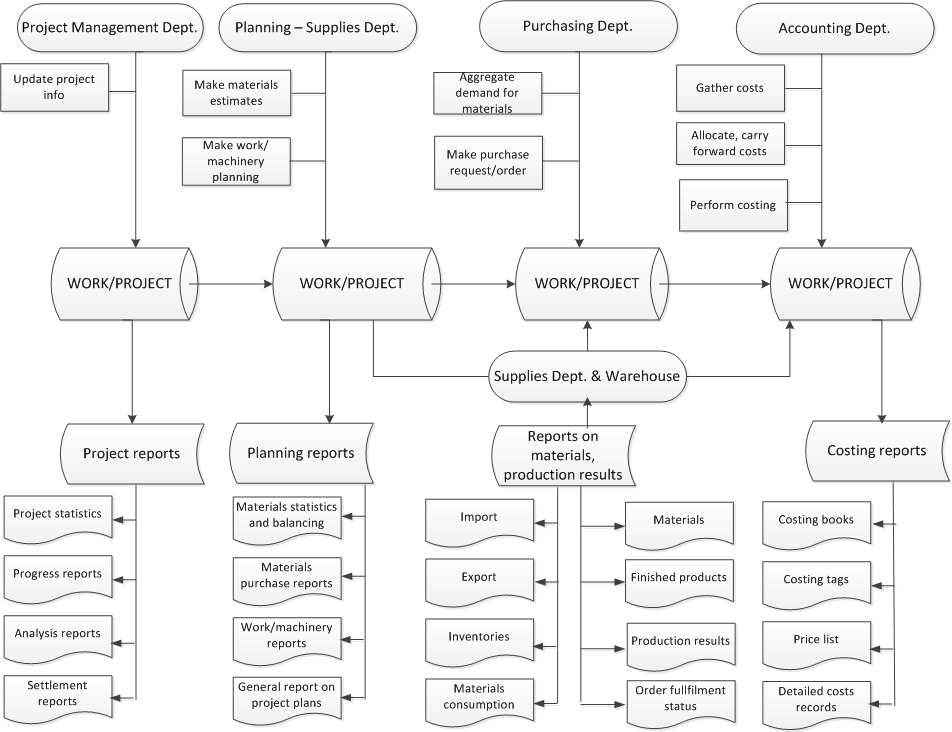
To operate the system, it is needed to set up some following information:
- List of projects – works/items/construction phases.
- List subcontractors, cases/case groups.
- List of works/List of construction machinery/List of workers
- Price list of: materials, construction machinery, workers, etc.
- Declaring work norms
- General estimation of Materials, labor and construction machinery for each item/work.
- Incurred estimation: materials, construction machinery, workers.
- The system provides the function to update price estimate on the estimation report.
Professional management and finalizations of works
- Step 1: The project department declares information about the project/work/contract.
- Step 2: Estimation/plan for each stage/item/work/project will be made, including work plan, plan for materials and machinery, payment plans, etc.
- Step 3: Balancing demand with supplies inventory -> Setting up a detailed request of supplies for each item/work/project. Making a report balancing demand for labor/machinery.
- Step 4: Making a request for supplies -> Approval -> Purchase order.
- Step 5: Purchasing supplies for warehousing -> Exporting according to the exporting request.
- Step 6: Gathering the costs of materials, labor, machinery and equipment -> Project settlement.
Some basic report templates on project estimation management of the system:
- Estimation for materials and labor costs for each work item/project:
- Estimation of the number and value of raw materials for each work item
- Estimation of the number of working days and wages for each work item: The software will aggregate the estimates for the work items to make total estimation for the whole project
Functions and management of construction/installation contractors:
Process and model of the cost gathering module for construction cost calculation:
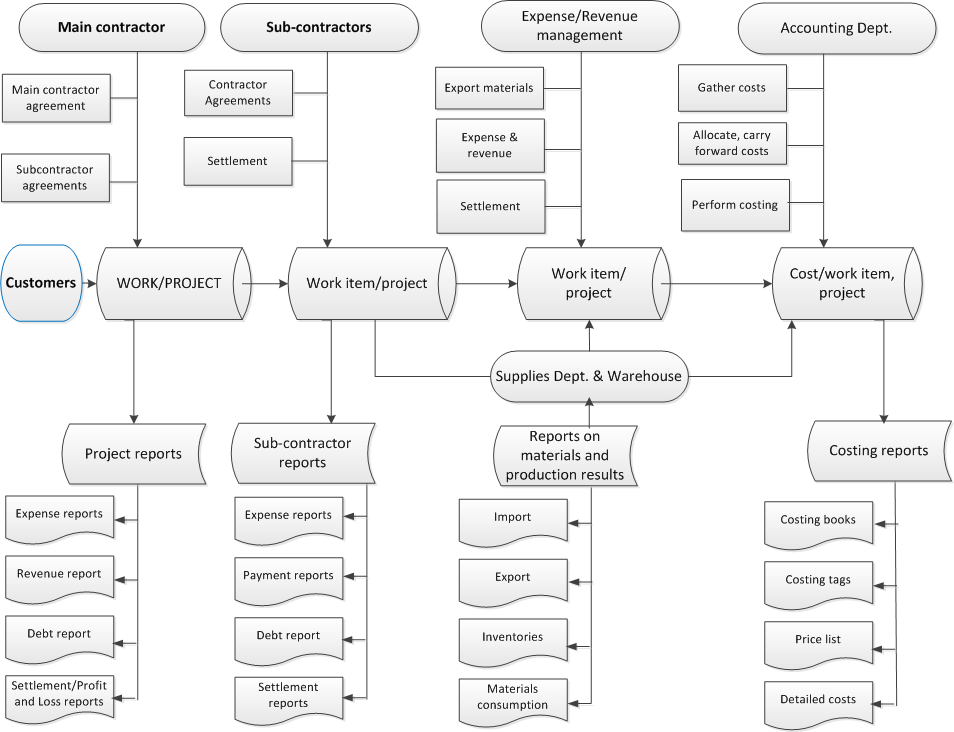
Interpretation of the process:
- Case 1: The enterprise is the main contractor.
- Step 1: Declaring information about the project/work and the main contractor contract
- Step 2: Declaring subcontractors and subcontracts for the work items/works (if subcontractors are used)
- Step 3: Managing the materials and costs used for the construction and installation process for each item/work.
- Step 4: Managing the payment and settlement with the subcontractors under the contract/work item.
- Step 5: Gathering the costs for calculation of the price for each work item and the project as well.
- Case 2: The enterprise is seen as a subcontractor (other unit is named the main contractor)
- Step 1: Declaring information about the project/work and the main contractor contract (Note: In the list of project works -> Recording the contractor and accrued expenses)
- Step 2: Managing the materials and costs used for the construction and installation process for each item/work.
- Step 3: Managing the payment and settlement with the subcontractors under the contract/work item – stage with customers.
- Step 4: Gathering the costs for calculation of the price for each work item and the project as well.
Some specific characteristics of financial accounting in the field of construction investment:
Liability and invoice accounting:
- Liability management: detailed liabilities of several subjects: invoice/contract/project/client.
- The management accounting function has been added and the query of report aggregate and detailed liabilities of any or all project/suppliers over time has been designed.
- The management accounting function has been added and the query of report aggregate and detailed liabilities of suppliers/any or all projects over time has been designed.
- The function to process liabilities which the invoice value differs from the actual liability incurred for each project has been also added.
Cost accounting – project settlement:
- Gathering the costs for calculation of the price for each work item/work/project.
- Cost of materials gathered by name for each work item
- Labor costs, general production costs allocated in proportion to the value of materials used for each work item/work
- The slip for delivery directly from suppliers to consumer without warehousing has been added and monitored by work item, keeping track of supplies and deducting supplies for each phase of acceptance.
- Managing and synthesizing all costs incurred by work item/project to carry forward into the cost of each project and generate the report on revenue/cost/profit and loss by work.
- Collecting costs and calculating the cost of works by each phase of acceptance. Determining profit and loss by each phase of acceptance
- Cost accounting for COMMERCIAL APARTMENT BUILDER:
- Managing and synthesizing all costs incurred by work item/project to carry forward into the cost of each project and generate the report on revenue/cost/profit and loss by work/apartment.
- Calculating the price of the apartment in 2 steps!
- Step 1: Gathering cost and calculating the price by product group of a project -> A complete project is divided into several groups of construction products, such as Apartment, commercial apartment, terracotta.
- Step 2: Using the price of a construction product group and allocating the number of such products of each group for each m2
- General cost allocation accounting entries for products are designed under 03 criteria: product area or coefficient, or the percentage of sales of each product to apply the rational allocation entries based on the costs incurred.
BUSINESS MANAGEMENT OF REAL ESTATE;
Management at the extend of tracking basic information and statistics of real estate sales by product/contract:
Business management – sales functions, monitoring and payment of debts:
- Establishing and declaring the shared directories for real estate business:
- Investor information: Code and name of the project investor.
- The list of projects/works: Project code, project name, location, number of units/lots, notes, etc.
- Product categories:
- Product groups:
- Blocks:
- List of charges: Fee of investors (brokerage fees), expenses for sales executives and collaborators for each product/projects//investor.
- List of sales departments/salesman/collaborators.
- Customer list.
- Functions and professional management of real estate sales (Lots, parcels, apartments):
- Declaring the list of contracts: sales and purchase, deposit, reservation.
- Converting the contract status: reservation -> Deposit -> Sales and purchase
- Declaring information on the contract such as
- Contract No., name, date, date of delivery, stakeholders, value, VAT;
- Customer information, brokerage staff, support staff
- Information on the product: Product code/project/investor/exchange, etc., seller;
- Information on the charges by product/contract.
- Updating the transaction status according to the contact, collecting bill and charging the stakeholders.
- Report system:
- Apartment state: Showing the transaction status.
- Sales reports by contract/exchange/investor/project/apartment.
- Report on the debt collection by contract/product.
- Synthesis report of costs by contract/product/investor/employee and collaborator.
Management of real estate sales – brokerage transactions through exchanges:
The link between Exchanges and Financial Accounting:

Management of Real Estate Brokerage:
- Establishing the list of management – business subjects:
- List of investors
- List of projects, blocks, product groups/products (apartments).
- List of charges: Fee of investors (brokerage fees), expenses for sales executives and collaborators for each product/projects//investor.
- List of sales departments/salesman/collaborators.
- Customer list.
- Operational process:
- Creating a tool to import brokerage transaction data from the BOOK CAN software export into the software to inherit transaction data by contract and making accounting entries of income – expense, billing, etc.
- Declaring the list of contracts and transaction information related to get data from the list of BOOK CAN software -> convert the contract state: reservation -> Deposit -> Sales and purchase such as Contract No, name, date, date of delivery, stakeholders, brokerage staff, support staff, product code/project/investor/exchange/seller, charges by product/contract: brokerage fees with the investor, fees for sales executives, customers, collaborators (if any).
- Updating the transaction status according to the contact, collecting bill and charging the stakeholders.
- Report system:
- Reports on transaction of exchange from …. to ……
- Apartment state: Showing the transaction status.
- Sales – brokerage reports by contract/exchange/investor/project/apartment.
- Report on the debt collection and incurred revenue by contract/product.
- Synthesis report of costs by contract/product/investor/employee and customer.
OTHER MODULES
- Finance – Accounting management
- Cash & banking
- Purchases/services and payables
- Sales/services and receivables
- Cost & pricing management
- Inventories
- Fixed assets, instruments and tools
- Synthesis of financial statements & tax reports
- Human resources management and payroll calculation
Demo
Please contact the company’s sales department for advice:
- Hanoi: 1900 63 65 85
- Ho Chi Minh: 1900 63 66 89
- Da Nang: 023 6222 9308



